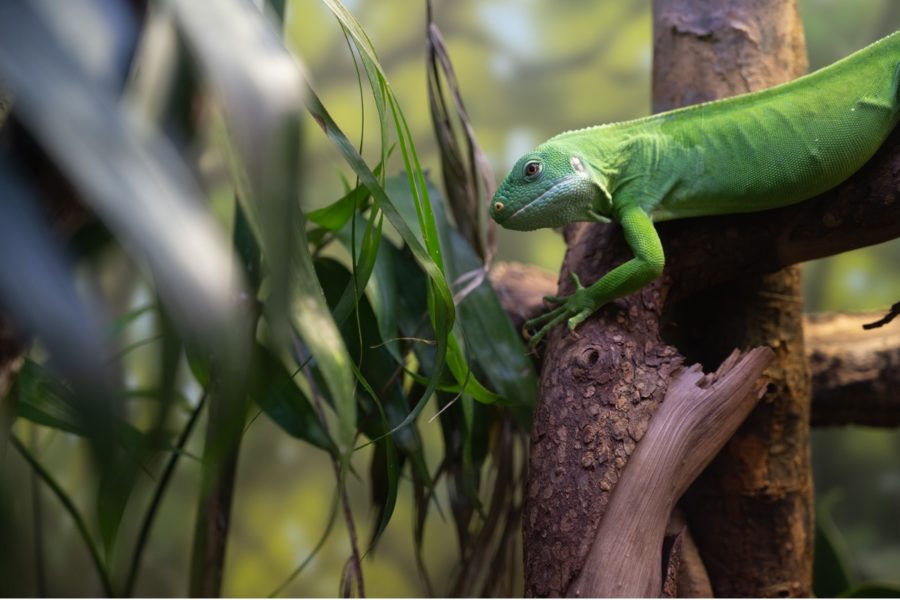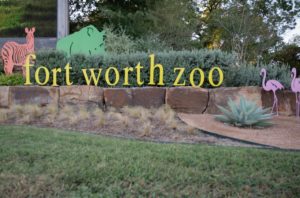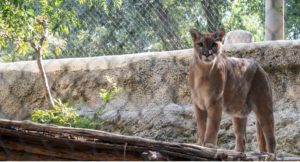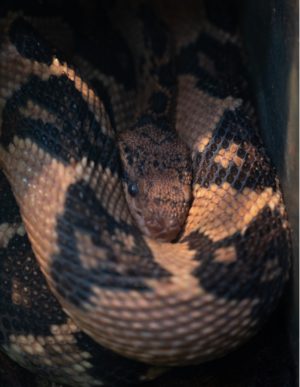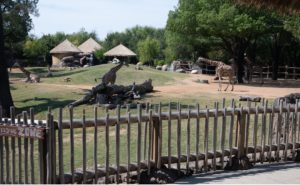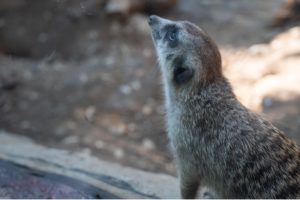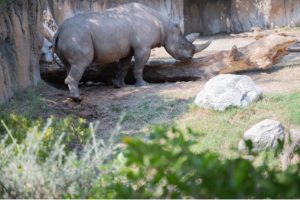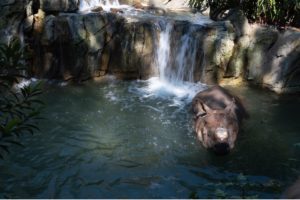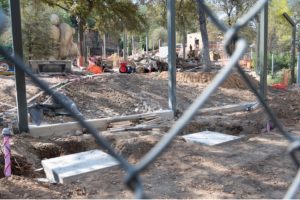The Fort Worth Zoo’s many conservation programs benefit endangered and threatened species around the world like this female Fiji banded iguana, according to the zoo. In the past 30 years, it has successfully bred and released hundreds of iguanas and other animal species back into the wild. (Photo/Sally Verrando/TCU)
By Sally Verrando, Staff Writer
Published Nov 10, 2022
When it comes to a zoo outing, some TCU students may hearken back to those chaotic family times with kids running, parents shouting and someone ending up crying.
But a visit to a zoo as an adult, without children in tow or being a youngster, offers another experience altogether with time—leisurely and lingering.
The Fort Worth Zoo — a five-minute drive north of the TCU campus — will celebrate 30 years and $300 million of habitat improvements, added attractions and conservation programs at the 30th Anniversary Festival on Nov. 19. Visitors get half-price admission to the all-day festival.
The celebration will include live music and entertainment, freebies while they last, photo-ops and enrichment activities at some of the animal exhibits, said Avery Elander, the Fort Worth Zoo spokesperson. The zoo’s baby western lowland gorilla that was born on Nov. 6. will also be at the festival.
Phase III of the current $130 million makeover, “A Wilder Vision,” is underway for big cat habitats and is expected to open spring 2023, Elander said. The zoo plans to have Forests and Jungles, the final Phase IV of “A Wilder Vision,” open by 2025.
This photo essay, taken at the Fort Worth Zoo on Oct. 10, offers a glimpse of what visitors can expect:
-
Phase III of “A Wilder Vision,” called Hunters of Africa and Asian Predators, opens spring 2023 with new habitats for lions, tigers, leopards, hyenas, African wild dogs and more. Phase IV, Forests and Jungles opening 2025, will provide improved environments for primates. (Photo/Sally Verrando/TCU)
-
The Fort Worth Zoo is open seven days a week. It is the oldest continuous zoo site in the state, created in 1909, according to the website. (Photo/Sally Verrando/TCU)
-
The Yellow Rose Express transports visitors from the zoo’s entrance to the Old West-styled main street of the Texas Wild! section, commemorating Fort Worth’s Cowtown history. Texas Wild! was established in 2001, the Fort Worth Zoo reports, and houses 300 animals representing six state environmental regions. (Photo/Sally Verrando/TCU)
-
Texas Wild! is home to animals native to the state, such as mountain lions, black bears, otters, a red-tailed hawk and other critters. The Mountains and Desert region is closed for renovations to be completed by fall 2023, including the exhibit for the Texas horned lizards. Further improvements to Texas Wild! are anticipated after Phase IV completion. (Photo/Sally Verrando/TCU)
-
This bushmaster, a South American pit viper, is one of 300 species of reptiles, amphibians and exotic fish at the Museum of Living Art, Elander said. The Fort Worth Zoo in 2010 unveiled the award-winning MOLA building that replaced the 1960-era herpetarium. (Photo/Sally Verrando/TCU)
-
The Fort Worth Zoo’s many conservation programs benefit endangered and threatened species around the world like this female Fiji banded iguana, according to the zoo. In the past 30 years, it has successfully bred and released hundreds of iguanas and other animal species back into the wild. (Photo/Sally Verrando/TCU)
-
Reticulated giraffes, African antelopes and ostriches roam together on a 10-acre open habitat in the African Savanna exhibit. Opened in 2018, this was Phase I of “A Wilder Vision,” the current $130 million renovation for the Fort Worth Zoo, according to its website. (Photo/Sally Verrando/ TCU)
-
This meerkat scans the sky for predators in the African Savanna exhibit. The group, or mob of meerkats, joined the park in 1997 as part of the past 30 years of upgrades and added habitats, according to the Fort Worth Zoo. (Photo/Sally Verrando/TCU)
-
A southern black rhinoceros, an endangered species, resides in the zoo’s African Savanna. As a founding member of the International Rhino Foundation, the Fort Worth Zoo is the only organization to manage a successful breeding program for this species in the U.S., Elandar said. (Photo/Sally Verrando/ TCU)
-
This greater one-horned rhino lives in Elephant Springs, Phase II of “A Wilder Vision” that opened 2021. Three generations of Asian elephants also inhabit Elephant Springs and are part of the Fort Worth Zoo’s successful breeding program through the International Elephant Foundation. (Photo/Sally Verrando/TCU)
-
Phase III of “A Wilder Vision,” called Hunters of Africa and Asian Predators, opens spring 2023 with new habitats for lions, tigers, leopards, hyenas, African wild dogs and more. Phase IV, Forests and Jungles opening 2025, will provide improved environments for primates. (Photo/Sally Verrando/TCU)
-
The Fort Worth Zoo is open seven days a week. It is the oldest continuous zoo site in the state, created in 1909, according to the website. (Photo/Sally Verrando/TCU)

